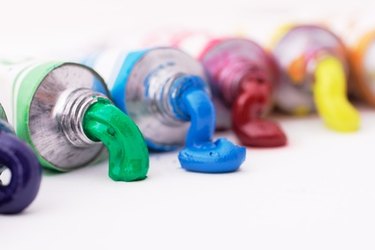Things You'll Need
Paint stripper
Old paintbrush
Paint scraper
Steel wool
Lacquer thinner
Medium- and fine-grit sandpaper
Orbital sander

There are three reasons why paint may not dry properly and leave a gummy mess on the painted surface. The first is that grease, silicone, wax or some other substance on the surface interfered with the drying of the paint. The second is that a corrosive substance was introduced to the surface after it was painted and the third is that the paint didn't contain sufficient drying agents. In all cases, you have to remove the paint to correct the problem, and this usually involves paint stripper, thinner and sandpaper.
Step 1
Spread paint stripper on the gummy paint with an old paintbrush and scrape it off with a paint scraper. Since the paint isn't hard, you won't have to wait for the stripper to dissolve it and can begin scraping right away. If the painted surface is metal, you may be able to scrape off the gummy paint without using a stripper. Scrape lightly so you don't scratch the metal.
Video of the Day
Step 2
Moisten a pad of coarse to medium-coarse steel wool in lacquer thinner and rub the residue from the surface you scraped. If the surface is metal, use fine steel wool so you don't scratch the surrounding areas of hard paint. The lacquer thinner will neutralize the stripper, remove remaining undercoatings of paint and clean off grease, wax and silicone that may have been interfering with the adhesion.
Step 3
Sand the surface and feather the edges of the repair into the the surrounding areas of hard paint. Use 120- to 150-grit sandpaper for a wooden surface and 220-grit paper for a metal one. If you are repairing a large area, use an orbital sander to make the job go more quickly.
Step 4
Rub the repair down again with steel wool soaked in lacquer thinner if the sandpaper gums up quickly when you are sanding. Gummy sandpaper indicates residue remaining on the surface that may interfere with the adhesion of a new coat of paint.
Tip
If you are mixing your own paint, add Japan drier to the mixture to promote drying and prevent a recurrence of gummy buildup.
You may be able to strip small areas of sticky paint with a strong household cleaner or isopropyl alcohol.
Warning
Wear rubber gloves and safety glasses while using paint stripper and a respirator while using lacquer thinner.
Video of the Day